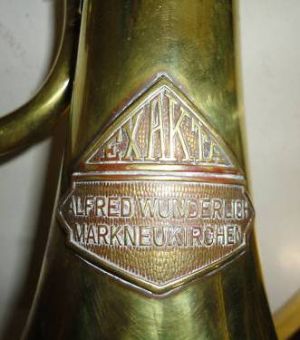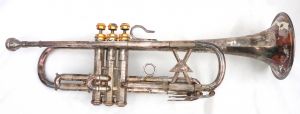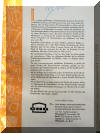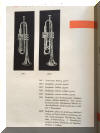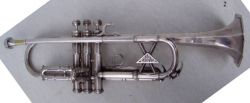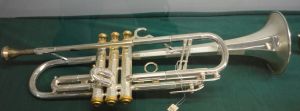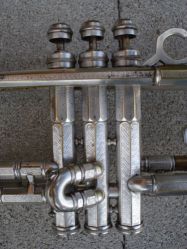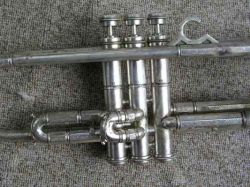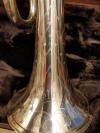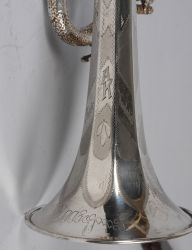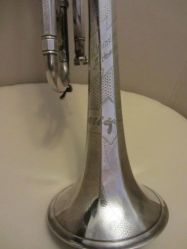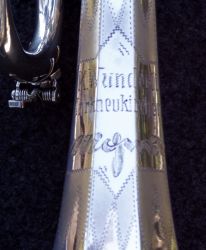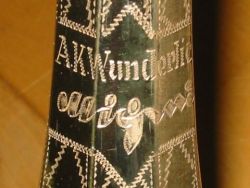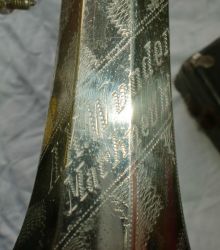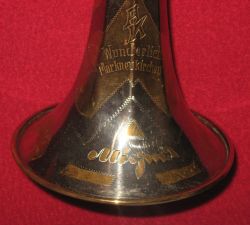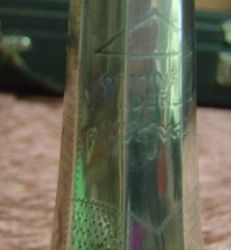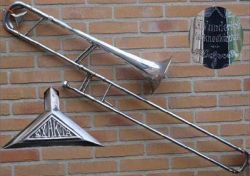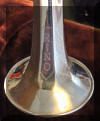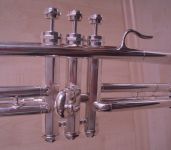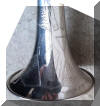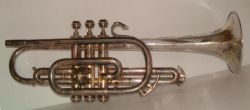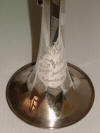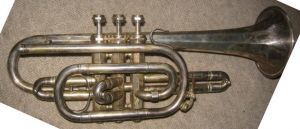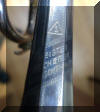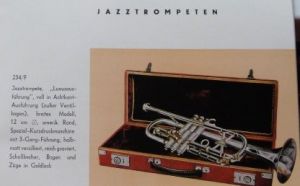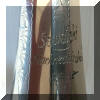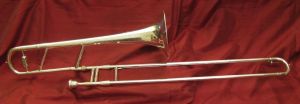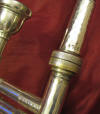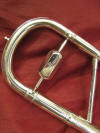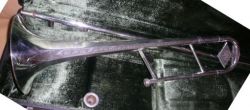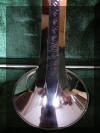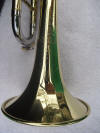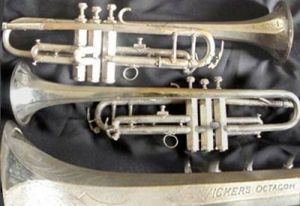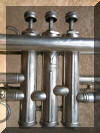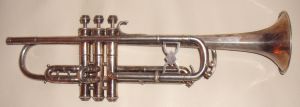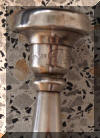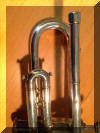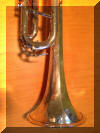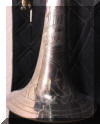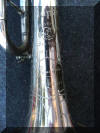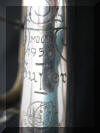The Exakta is a type of Octagonal trumpets. From the forties till the seventies octagonal trumpets were made by GDR makers from Markneukirchen operating in the Sinfonia and Migma groups, like Kurt Knoth, A.K. Wunderlich and Johannes Scherzer. "This peculiar shape of brass instruments was interesting to show orchestra's. That was going on already in the 1940s", says museum direktor Heidrun Eichler from Markneukirchen.
The company A. K. Wunderlich in Markneukirchen was known for their 'Exakta' trumpets, but also build french horns and trombones. It was founded in 1907 by Alfred Wunderlich(26.05.1883 - 01.01.1969).
Contents
- 1 The Exakta and other octagonal bell trumpets from Markneukirchen
- 2 Wunderlich's Exakta
- 3 Migma & Sinfonia
- 4 Alberto, Albert Wolfram Markneukirchen
- 5 Super
- 6 Horst Voigt, Markneukirchen
- 7 Joseph Pscherer
- 8 Erhard Sawatzki's dodecagonal trumpets
- 9 Vega
- 10 Vickers
- 11 Couesnon Paramount
- 12 No names
- 13 Steenhuysen, Brussels
- 14 Wonder Super
- 15 De Prins Super
- 16 The Arigra
- 17 Other trumpets with hexagonal valve casings
- 18 Sources
The Exakta and other octagonal bell trumpets from Markneukirchen
Brass instrument maker Mario Weller from Markneukirchen, who researches the history of 20th century brass instrument making in Vogtland, told me in March 2013: „Most of the brass instrument makers in the Vogtland made their octagonal bells out of standard bells, on their own rods. That's known for the workshops of Johannes Scherzer, A.K.Wunderlich and for the 12-sided version that came from the workshop of Erhard Sawatzki. The basic bells for all three workshops came from bell maker Heinz Nürnberger, formerly Firma Ernst Dölling, Markneukirchen. Heinz Nürnberger is known to have had his own 8 sided rod, that he lent to another Sinfonia member (Otto Meinel) when needed. Also known is that around 1950 instrument and bell maker August Reichel jun. made octagonal bells and sold them to Vogtlandian instrument makers.
Wunderlich's Exakta
The company A. K. Wunderlich in Markneukirchen was known for their 'Exakta' trumpets, but also build french horns and trombones. It was founded in 1907 by Alfred Wunderlich(26.05.1883 - 01.01.1969). His father and brother were both active as brass instrument makers. Alfred joined with this brother under the name „Gebr. Wunderlich“. Around 1938 his son Kurt Wunderlich (16.05.1908 - 10.05.1994) became his partner, hence the name A. K. Wunderlich ('A' for Alfred, 'K' for Kurt). In the shop at Mosenstraße 10 they had up to 6 people working. Many apprentices were trained, some of whom continued their craftsmanship in a workshop of their own.The company was dissolved in 1990.
Most of their octagonal trumpets were build from 1945 till ca. 1970/75, After that interest strongly declined. Here's an Exakta, A.K. Wunderlich, with the caracteristic triangular spin that also is found on Sinfonia instruments, and gold lacquered valve caps and bottoms. The inside of the bell is also gold lacquered.
Catalog "Alles für den Musikfreund', GHG Möbel- und Kulturwaren Bezirk, Karl-Marx-Stadt, Klingenthal
This Wunderlich Exakta is listed in a 1961 catalog from the Grosshandelskontor für Möbel-und Kulturwaren from 1961. It comes in three versions, with only the bell octagonal, bell and valve block octagonal and a fully octagonal one (except tubes). In a 1962 pricelist it's offered for (DDR) DM 275, DM 365 and DM 400 for the luxury version. Here's another Exakta, with an octagonal bell rim.
A double-braced Exakta
Wunderlich made these octagonal bell trumpets with hexagonal shaped valve casings but also with round valve casings. Hammered tubes are found on a lot of these trumpets, others are engraved.
He also made trumpets with hexagonal valve casings and a round bell. Here's an Exakta with the name Weltton on the bell. The Weltton ('world sound') brand was used between ca. 1953 and 1977.
The bell engravings also vary to quite some extent. AK Wunderlich and Markneukirchen and/or Migma are common. There's also an 'Originel Wunderlich'.
Wunderlich also made Exakta octagonal trombones with double braces.
Migma & Sinfonia
Musical instrument makers around Markneukirchen were organised in cooperatives, for the purchase of materials and selling of products. Wunderlich was member of Migma, an acronym for "Musikinstrumenten Genossenschaft Markneukirchen", a cooperative with at a time several hundred musical instrument makers, established in 1943 and still existing. Other workshops were organised in Sinfonia, a production cooperative (PGH, Produktions Geselschaft) that existed as of 1960. In the seventies, wenn it became clear that with export of hand made instruments foreign currency could be acquired, the PGH Sinfonia was transferred into a 'Volkseigene Betrieb' (VEB Sinfonia), a state organisation. In 1984 the VEB SINFONIA became VEB Blechblas- und Signalinstrumentenfabrik Markneukirchen. In 1990 VEB B & S became the Vogtländische Musikinstrumentenfabrik GmbH (VMI).
Members of PGH Sinfonia were amongst others Johannes Scherzer, who in 1961 took over the workshop of his uncle Kurt Knoth (both using the tradename 'Rino'), Karl Mönnich, Albert Wolfram, Otto Meinel, Walter Mönnig, Erhard Sawatzki as well as the Philipp Reichel workshop with his 'subdivisions' Armin Glier and Klaus Wolfram.
The workshop of Kurth Knoth and his successor (and nephew) Johannes Scherzer made several hundreds of octagonal trumpets, according to Mario Weller. Kurth Knoth took over the Rino workshop from his father Emil in 1935, and moved it to the Mosenstraße 13 in Markneukirchen. In 1961 Kurt Knoth who was a member of Migma, joined the PGH Sinfonia. As of 1961 Johannes Scherzer was in charge of the workshop. The Scherzer workshop then in 1984 became part of the VEB Blechblas- und Signalinstrumentenfabrik.
Here's an octagonal trumpet engraved Kurt Knoth Instr.Baumeister with trademark Rino and sold through Migma, with hammered tubing and gold wash bell. Dated 1940 -1950 by the 2014 Ebay seller, but as it's engraved Migma it can't be before 1943.
A Rino octagonal trumpet with Sinfonia on the spin and Rino on the bell and pinky hook. As it's marked Sinfonia it must be later than 1960
Here's another trumpet marked Scherzer, with octagonal valve casing, bottoms and caps, similar to those of the Kurth Knoth above. This one however has a hexagonal bell and hexagonal ferrules. It was offered on Ebay from 2014 till 2015 by instrument maker Simon Freyer in Friedrichsdorf, who believes it's a one off. The serial number is 4956, the valves are marked 37,38,39.
As a side step, a no name trumpet that presumably also has it's origins in Markneukirchen. Some octagonal tubes, hammered bell, valves and other details hexagonal. On the bell: Musik Kapelle 'KVB' No 2. The seller suggests that it may have been playd in the orchestra of the Kölner Verkehrs Betriebe (the transport company of Cologne) .
Alberto, Albert Wolfram Markneukirchen
Albert Wolfram (+2007) who started his workshop in 1957 used the tradename Alberto. His son Gerhard Wolfram is the last known instrument maker in Markneukirchen still building octagonal trumpets.
The octagonal trumpets of Albert Wolfram appear regularly at sites like Ebay.
Super
An octagonal trumpet with a valve block similar to the above Wolfram appeared on Ebay in 2016. It has the name Super on it, a number (624?) on the valve block and no Sinfonia spin.
Horst Voigt, Markneukirchen
An octagonal cornet was signed by Horst Voigt, Markneukirchen. Horst Voigt (1920 - 1994) was educated at A.K. Wunderlich and opened his own workshop in 1951. In 1953 his many years younger brother Helmut joined him.
Another octagonal cornet that has octagonal valve caps and valve casings. No makers name, presumably older than the Horst Voigt cornet and definitely no Arigra as is suggested in it's ebay ad
Joseph Pscherer
Meister Joseph Pscherer was born in 1909 in Eibenberg (7km from Graslitz, now Czech). According to Mario Weller, he got his education in Graslitz and worked from 1953 till 1978/1980 in Klingenthal, 7 km from Graslitz on the German side of the border. He passed away around 1996. Pscherer always worked alone and had his instruments sold through the Migma collective, and incidentally also through PGH Sinfonia, as Weller states. This instrument has no reference to either Migma or Sinfonia.
Other workshops made octagonal trumpets under the Sinfonia name, some are only marked Sinfonia, without a maker. A 1961 GDR catalog shows an octagonal trumpet, in luxury version. It has gold lacquer in the bell and on the bows. The catalog ("Alles für den Musikkfreund") was issued by the Grosshandelskontor (GHB) für Kulturwaren in Karl-Marx-Stadt (now Chemnitz). The GHB was a new wholesale organisation in the socialist GDR that existed as of 1960.
Erhard Sawatzki's dodecagonal trumpets
Erhard Sawatzki (03.08.1924) was educated at the A.K. Wunderlich shop from 1939 till 1942 and worked there till April 1963. He worked as in independent instrument maker from 1963 till 1990, being a member of Sinfonia, where his workshop had the number 4, as a prefix to their serial number. He made trombones, trumpets, flugelhorns, cornets, tenor and french horns in different models, some 2000 instruments all together. His specialty were dodecagonal trumpets, with bell, valve caps and tubes 12-sided.
Here's a Sawatzki dodecagonal trombone, offered on Ebay in 2019. It's marked SAMA and Sinfonia and has number 4 162, so one of his earlier instruments.
Sawatzki, like Wunderlich, also made octagonal trombones.
Vega
Vega, an American maker of musical instruments from Boston, made a octagonal trumpet as well. Model Hi-voice, serial number 40143, refurbished in 2012 dates probably from around 1950. Vega started in brass production with the aqcuisition Standard Band Instrument Company of Boston in 1909. The Vega trumpets and cornets were popular with jazz artists as well as the later big bands and solo artists such as Miles Davis; they enjoyed a comfortable niche in the professional market. However, producing handcrafted professional horns without keeping an eye to the increasing demand for student instruments, the company dropped their horn production to concentrate on their stringed instrument sales. In 1970 Vega was bought by C.F. Martin.
Vickers
On Horn-u-copia.net there's a Vickers Octagon, with serial number 2025. The seller dated it between 1925 and 1935. The origin is unclear. One possibility is that it was imported by J.J. Vickers and Sons, who early into the 20th century had become the principal importer of musical instruments in the UK, offering everything except pianos. But that's just a wild guess.
Couesnon Paramount
A Couesnon Bb/C trumpet with hexagonal valve slide knobs, valve bottoms and 5 ridges on the valve casings and a art-deco'ish geometrical design on the bell. The valve casings remind of Bohland & Fuchs.
No names
Then there are the unidentified octagonal trumpets. The first one, owned by Dieter Grosche, has similarities to the Markneukirchen trumpets.
Another no name trumpet, richly decorated. Valve caps hinting on Markneukirchen, as does the mouthpiece that goes with it (not necessarily original).
The University of Edinburgh suspects it's octagonal trumpet to be 'possibly German, ca 1950'.
An octagonal bell trumpet with hexagonal valve block/caps/bottoms
And an octagonal trumpet that's owned by Richard Jereb, Vienna. The octagonal form has been consequently continued in different parts, like the caps of the water-keys (made of copper, not brass), junction rods, all pipe junctions. Also the finger ring and the handles of the slides are octagonal. No makers name or whatsoever, only an 1 on the middle valve casing. A stylized violin key on the tuning slide. Valve casings resemble Kühnl & Hoyer although the owner doesn't believe it could be West-Germany. The combination of brass and nickel silver means it's not older than 1970, according to Mario Weller, who's also convinced it's not Markneukirchen made.
Steenhuysen, Brussels
A hexagonal bell and hexagonal valve casings and caps are distinct features of a trumpet that's branded Swing. Swing is believed to be a trade name of Steenhuysen, a brass manufacturing company in Brussels. Pierre Steenhuysen worked for Mahillon before he started his own workshop in 1926. His grandson bought Mahillon in 1970. The bell isn't hexagonal till the end, there's a saxophone player engraved on the bell. Steenhuysen made a Wonder model trumpet, and used similar hexagonal valve caps and bottoms and a rimless bell on other models/instruments, like the Swing Special.
Wonder Super
A trumpet marked Wonder Super, round (rimless) bell with hexagonal valve casings, ferrules, valve caps and bottoms. Most probably from Belgium; Horn-u-copia lists a Wonder Super trombone engraved 'Fabrication Artistique'. Collector Peter Willemsen believes that Wonder Super aalso was a tradename of Steenhuysen.
Almost the same trumpet was sold under the name J van Dorpe, Courtrai (Kortrijk) also in Belgium. The main difference is the spin. It's engraved Model Wonder Professional.
De Prins Super
The hexagonal valve casings are also found on trumpets from Belgian maker De Prins from Antwerp. The De Prins Super trumpet features these hexagonal valve casings. De Prins and later Gebr. De Prins (brothers De Prins) were located in Antwerp, as of 1901. The brothers took over after WWI. Gebr. De Prins had a complete Super line of instruments. The company existed until 1980.
- 3De Prins hex VC 2-3 small.jpg
De Prins Super, gebreveteerd sr.nr. 17861, Antwerpen België source: Peter Willemsen
De Prins Gebrs Grote Prijs, Gouden Medaille Antwerpen België Super model 1950 gebreveteerd sr.nr. 13357 source: Ebay.de 2014</small<
The Arigra
Click on the following title for an overview of and the story behind the Arigra
Other trumpets with hexagonal valve casings
Click on the following title to view an overview of Other trumpets with hexagonal valve casings
Sources
- G.Dullat Der Musikinstrumentenbau und die Musikfachschule in Graslitz von den Anfangen bis 1945
- The New Langwill Index
- Ebay and the rest of the internet
